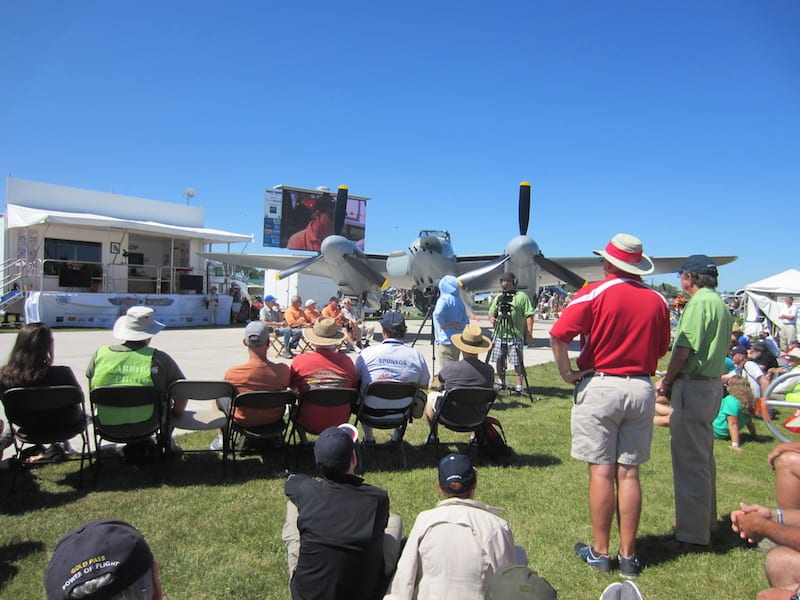Highlighting AirVenture for many warbird fans was the appearance of a rebuilt de Havilland Mosquito owned by Jerry Yagen of the Military Aviation Museum in Virginia Beach, Virginia.
Almost 8,000 Mosquitoes were built during the 1940s, but Yagen’s plane is one of only two examples that are airworthy today. The rare plane, made largely of wood, flew in the airshow and was presented at one of the popular twice-daily “Warbirds in Review” programs.
“I would have come to Oshkosh just to see the Mosquito fly,” said Morty Lloyd, a pilot and warbird enthusiast from Chattanooga, Tennessee.

When not being featured, Yagen’s Mosquito was parked next to one owned by Kermit Weeks, which is on loan to the Experimental Aircraft Association (EAA) Museum, but has not flown in many years. In 2014, a second airworthy Mosquito flew in western Canada for the first time in 48 years, but it has yet to appear at Oshkosh.
In addition to Yagen, the resurrected Mosquito was represented at AirVenture by Warren Denholm, who restored the unique warplane along with his crew at Avspecs in New Zealand.
After eight years of work and a test flight program at Denholm’s shop in Auckland, Yagen’s plane was disassembled and shipped to Virginia in three large containers. The Mosquito’s first U.S. flight after reassembly occurred in 2013 and its debut appearance at AirVenture this year earned the plane recognition as World War II Grand Champion Warbird, along with a Golden Wrench award for Avspecs.

Denholm explained that the lightweight World War II twin with a crew of two — pilot and navigator — was 30 mph faster than a Spitfire and could easily outrun any aircraft that Germany had at the time, making it ideal for high-altitude photo reconnaissance missions.
Later versions were easily able to top 400 mph and the Mosquito was configured as a night fighter, light bomber and VIP transport, all roles in which its superior speed and handling were significant advantages. Mosquitoes equipped as bombers were featured in the 1964 movie 633 Squadron.
 Due to a small rudder, the plane has poor single engine performance on takeoff or landing. “Once the gear is down, you’re landing,” said Denholm.
Due to a small rudder, the plane has poor single engine performance on takeoff or landing. “Once the gear is down, you’re landing,” said Denholm.
As a light bomber, the plane specialized in “harassment raids” deep into enemy territory and, due to its speed, the plane could make two round trips to Berlin each night, where it dropped 4,000 pound “Blockbuster” bombs nicknamed “Cookies.”

In one famous 1943 raid, a Mosquito knocked out the main Berlin radio station while Hitler’s No. 2 man, Hermann Goering, was making a speech, causing him to publicly chastise his own air force for their inability to stop the attacks.
To conserve valuable aluminum during wartime, the plane was constructed with a unique monocoque wooden fuselage made of three-ply Canadian plywood with balsa wood as filler material. Fortunately, Avspecs obtained sheets of the special plywood from the original manufacturer just before the company went out of business.
Following de Havilland’s original construction method, the plywood sheets were formed around new fuselage molds made by a New Zealand businessman with a passion for Mosquitoes.
The fuselage is built in vertical halves and glued and screwed together like a giant kit plane. The massive laminated wooden spar is 6 inches square and modern epoxies replaced original glues that were problematic during the war, especially in hot, humid climates.
In an interesting wartime connection to Wisconsin, some of the specialized wood veneer needed for the plane came from a manufacturer in Marshfield, only 106 miles from Oshkosh.
 In England during the war, a well-established cottage industry of wood furniture manufacturers made components for the plane, which was affectionately called “The Wooden Wonder” and “Mossie.”
In England during the war, a well-established cottage industry of wood furniture manufacturers made components for the plane, which was affectionately called “The Wooden Wonder” and “Mossie.”
Yagen noted that the project he bought in Canada “was terrible looking … it was a pile of mush and none of the wood was useable again.” Fortunately, many of the plane’s original metal components were in good shape and useable in the restoration.
Asked if any more Mosquitoes will be built off the specialized molds in New Zealand, Denholm said that two more are currently underway. Since both are scheduled to come to the U.S., it is possible that a small squadron of Mosquitoes could gather on the AirVenture ramp in years to come.

Thanks to all the rebuilders of these historic airplanes. My dream is to fly in one some lucky day. And hats off to its original designer, Geoffrey DeHavilland.